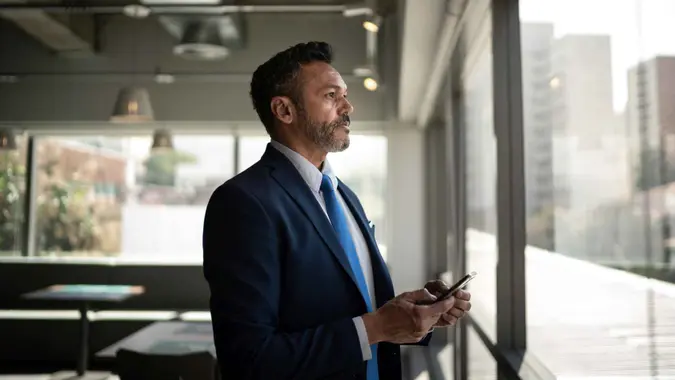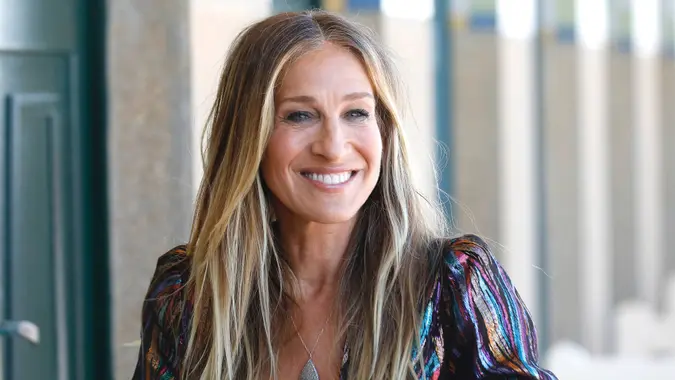Rachel Cruze: 5 Solutions to the Main Reasons It’s Hard To Retire

Commitment to Our Readers
GOBankingRates' editorial team is committed to bringing you unbiased reviews and information. We use data-driven methodologies to evaluate financial products and services - our reviews and ratings are not influenced by advertisers. You can read more about our editorial guidelines and our products and services review methodology.

20 Years
Helping You Live Richer

Reviewed
by Experts

Trusted by
Millions of Readers
Saving for retirement is challenging. In a recent survey of almost 500 Americans, 53% said they felt behind in their retirement planning, and only 54% reported having a retirement account.
Money pros say the retirement savings slowdown comes down to priorities. With high inflation causing low buying power, people must spend more money on necessities.
The experts get it. Money personality Rachel Cruze recently shared a video on the topic via her YouTube channel. “How to Happily Retire in a Broken System” touched on the three most significant challenges of retiring in the 21st century. Here’s a breakdown of those issues and what you can do about them.
1. Plan Access Isn’t Universal
If you live in the United States, your job significantly affects how much you can save. Over 55% of workers lack access to an employer-sponsored retirement plan, such as a pension or 401(k). Less than half of low-income workers — fewer than 25% in some states — have the same access.
Part of the issue is the lack of an employer mandate to offer such plans. In countries that automatically opt workers into retirement savings plans, participation is as high as 80%. Given that the option to emigrate isn’t universal either, most Americans are on their own.
Solution: Search For Jobs With Matched Plans
You may not be able to choose your country’s retirement savings policy, but you can choose where you work. As of 2023, 69% of private-sector and 92% of government employees have access to employer-sponsored plans. The vast majority of plans offer employer contributions.
When considering a job offer, consider retirement plan contributions and matching policies. Find out if you can contribute immediately, what salary percentage you can put aside, and when employer contributions activate. Cruze recommended investing the maximum allowed in an employer-matched plan to get the biggest benefits.
Solution: Open Other Investment Accounts
A 401(k) is just one way of saving for retirement. There’s also the option of a Roth IRA, which you don’t need an employer to open.
A Roth IRA takes post-tax contributions, so it won’t reduce your taxable income like a 401(k) will. However, it grows tax-free because you’ve already paid taxes on that money. You also don’t pay taxes on withdrawals in retirement, assuming you meet the age requirement of 59 1/2.
Roth IRAs have maximum yearly contributions that depend on your age group. Cruze suggested other investments, such as a mutual or index fund, if you want to save more. Non-retirement investments don’t have the same annual maximums, but the tax rules differ. Talk to a financial advisor if you have questions.
2. Saving Requires Discipline
Personal responsibility plays a significant part in American retirement planning. Cruze said people “drag their feet,” costing themselves money in the long run.
Retirement savings benefit from compound interest, which builds on itself. When your Roth IRA or 401(k) savings generate interest, that money becomes part of your account and generates more.
Saving early and consistently gives you an advantage, but the realities of daily life can make sticking to a plan difficult. Shorter-term needs or wants can make people question whether they can afford to save.
Solution: Stick To a Plan
Cruze said the best strategy is to “just do it.” Commit to a savings strategy and keep at it. However, she cautioned that it doesn’t mean setting and forgetting it.
Putting money into a retirement account is only step one. You must choose your investment types, watch the results and change things if necessary.
Solution: Automate Your Savings
If your employer takes your 401(k) contributions directly from your paycheck, you know how much easier it is to save when it’s automated. You don’t have to commit to depositing a certain amount. You don’t experience the anxiety of withdrawing money from your checking account.
You can automate savings for most retirement and investment accounts, even if they don’t come from your paychecks. Set up recurring transfers from your bank into the target account, then sit back and watch your balance grow.
3. People Need Money Now
Many retirement plans have early-access options, and tough financial times mean more people take advantage. In 2023, 3.6% of Vanguard participants took hardship withdrawals, compared to 2.8% in 2022.
Cruze called this phenomenon “leakage” because it drains money from your total savings. You end up spending money that would otherwise grow and build on itself. You could miss out on years of compound interest depending on how early you withdraw.
Also, hardship withdrawals are subject to federal and state taxes, including a 10% penalty tax if you withdraw before age 59 1/2. Your financial services provider may also charge an early withdrawal fee.
Solution: Build a Separate Emergency Fund
Hardships happen. Before you channel all your investable funds into your retirement account, open an emergency savings account and deposit three to six months’ living expenses.
If you don’t have that much available, save up month by month. Calculate how much you can put into your emergency account and set up direct deposits. When you’ve reached your goal, consider putting that monthly amount into your retirement or investment accounts instead.
Having an emergency fund gives you the cushion to keep your retirement account as a long-term investment. The longer you let it sit, the more it can grow.
Cruze’s No. 1 Action Step: Talk To a Professional
Cruze offered one piece of advice again and again throughout her video: Work with a financial professional. Even as the daughter of one of the most famous investment experts in the world, Dave Ramsey, she still sits down with an advisor.
Advisors understand the industry and the many options available to investors. They can help you choose investment products, plan how much to save and assist you in adjusting your strategy over time. They can, as Cruze put it, “Tell your money what to do.”
 Written by
Written by  Edited by
Edited by 

























